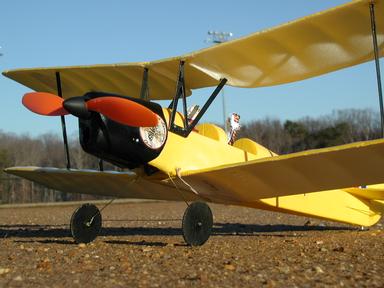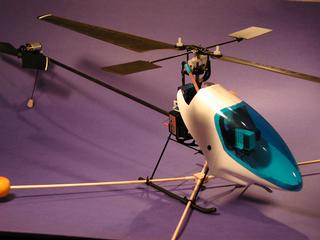

The Hangar Photos and discussions of all the airplanes, including how some of them were constructed, setup, and tuned.
Batteries Battery experiments I've done and general info on batteries used in electric airplanes
Simulators Links and discussion of remote control flight simulators
CDROM motors Experiments with CDROM motors
I built and flew small gas-powered control-line airplanes when I was young. I was somewhat interested in some sort of flying models, particularly to teach the grandkids about models, but was put off by safety issues and the mess of the fuel. I happened to drop into a hobby shop and was surprised to discover the existence of electirc-powered (small motors and batteries) model airplanes. That was intriguing!
It turns out that electric-powered model airplanes are becoming quite popular and that newer batteries and motors are available that yield flying times of anywhere from 7 to 20 minutes, depending on the plane, motor, and other factors. There is a challenge, however; batteries weigh a lot, relative to the weight of the plane, so building a plane that will fly easily and for a long time is more difficult than when flying with gas-powered engines. Another advantage of small electric planes is that they can often be flown at a local ball park instead of having to go to a flying club field.
I'm now learning about many of the factors that influence
electric-powered model airplanes. Factors like the weight of
materials, gluing techniques, aerodynamics, balancing airplanes for
flight, why a plane won't fly, etc. There are several
critical factors that make an electric airplane fly well:
As an example of the tradeoffs, the Tiger Moth uses an inexpensive 'can' type motor geared at 5.9:1 that draws about 1.5 amps at full speed when driven by a 7-cell (8.4-volt) battery. The propeller provided with the Tiger Moth is a 9x7, but I've found that a 10x4.7 provides better performance. I haven't noticed that the speed is slower with the 10x4.7 prop, but I have noticed that there seems to be more power for takeoffs and loops. The 650mAh and 720mAh battery packs I use provide me about 20 minutes of flying time each, as expected (figure 720mAh / 1.5A = .48 hours = 28 minutes). The actual flying time will be less due to losses in the speed controller and inefficiencies in the discharge of the battery pack. I've flown for 25 minutes on this plane/motor/prop/battery combination by running at about 1/2 throttle. I've tried an 11x4.7 and found the performance to be less. The thrust measurements I've made show the same difference in thrust with this motor and various propeller combinations - the 10x4.7 provides greater thrust.
Safety Note: one shouldn't fly R/C planes within 3 miles of an existing field due to transmitter interference. Also be aware of other people and pets around a ball park - even small planes can injure someone, though much less seriously than a heavy gas-powered plane. Join the Academy of Model Aeronautics to obtain liability insurance coverage and to learn the rules of flying.
Another Safety Note: Spinning propellers and
flying models are dangerous, even on small models. Propellers have
sharp edges and are spinning at speeds of 1,000 to 13,000 RPM. Even on electric
planes, a spinning propeller will cut fingers. Being hit by a small model
that weighs the same as a football will feel much like being hit by a football
travelling at that same speed. If you fly models at a local recreational
park, make sure any spectators are kept away from your flying area. Do
not fly over spectators, even though you and they often enjoy it. And
watch out for dogs that like to chase flying objects. I find that
the fenced ball fields are the second best place to fly if I don't go to
the flying club's field.
The flight of helicopters is sometimes humorously described as "beating the air into submission". A quote from Harry Reasoner (a well-known TV news reporter in the 1970s) pretty much says it all:
"The thing is, helicopters are different from planes. An airplane by it's nature wants to fly, and if not interfered with too strongly by unusual events or by a deliberately incompetent pilot, it will fly. A helicopter does not want to fly. It is maintained in the air by a variety of forces and controls working in opposition to each other, and if there is any disturbance in this delicate balance the helicopter stops flying; immediately and disastrously. There is no such thing as a gliding helicopter.
This is why being a helicopter pilot is so different from being an airplane pilot, and why in generality, airplane pilots are open, clear-eyed, buoyant extroverts and helicopter pilots are brooding introspective anticipators of trouble. They know if something bad has not happened it is about to."
Other humorous helicopter stories and comics, including Harry's quote, can be found at www.jollygreen.org.
Here is a video of a helicopter that is flown through a forest with the
same style that you might see an RC flyer. The only difference is that
the heli flyer here isn't likely to walk away from a crash or blade strike.
Heli in forest
<
How they inspect high voltage lines from helicopters. Just like birds sitting
on high voltage lines, these guys equalize voltage between the heli and the
lines, then climb onto the lines to do their inspection and/or repairs.
Just don't touch anything else!
Cable Inspector
Links to interesting videos, pictures, and other oddities of airplanes and flying.